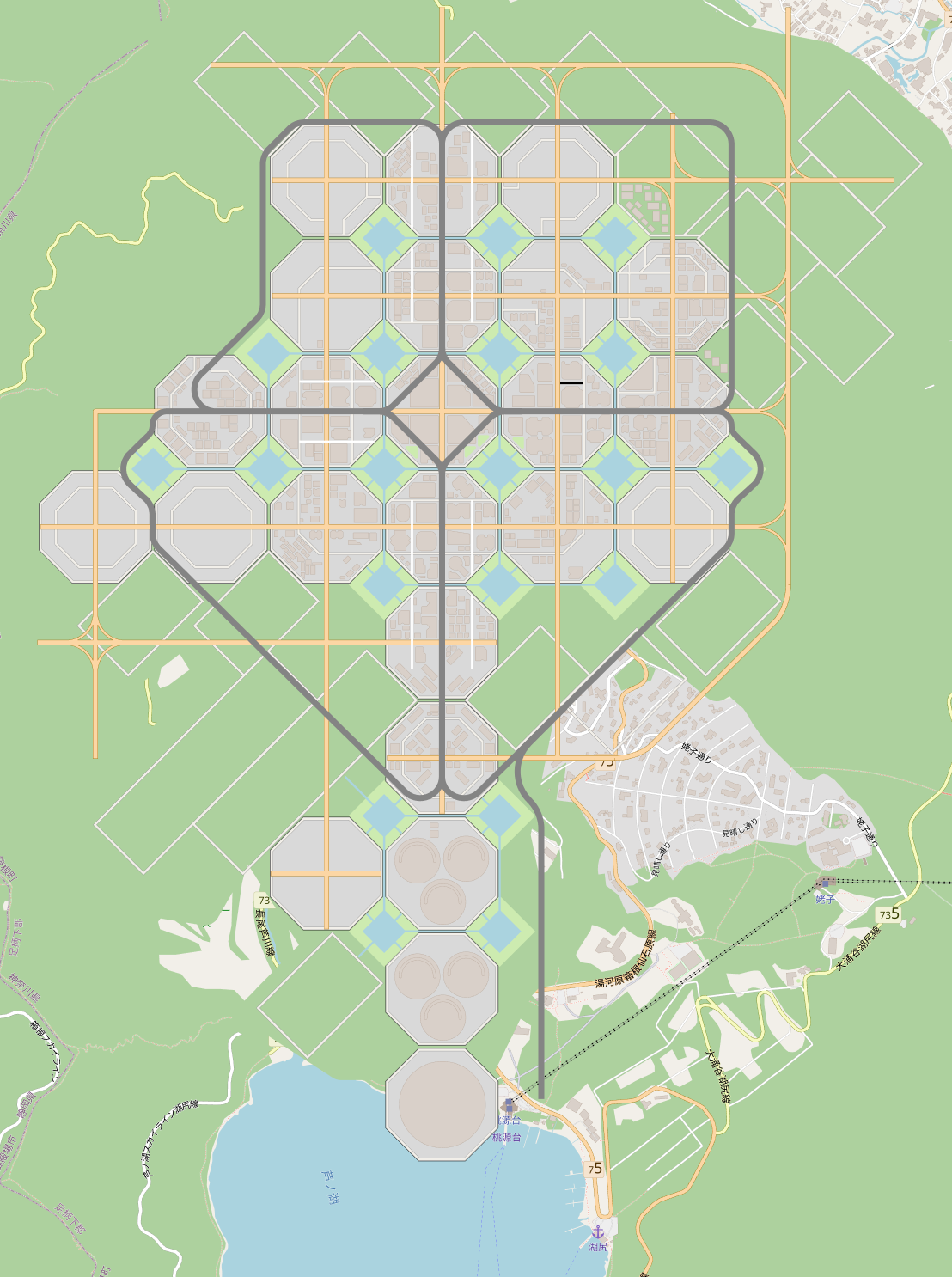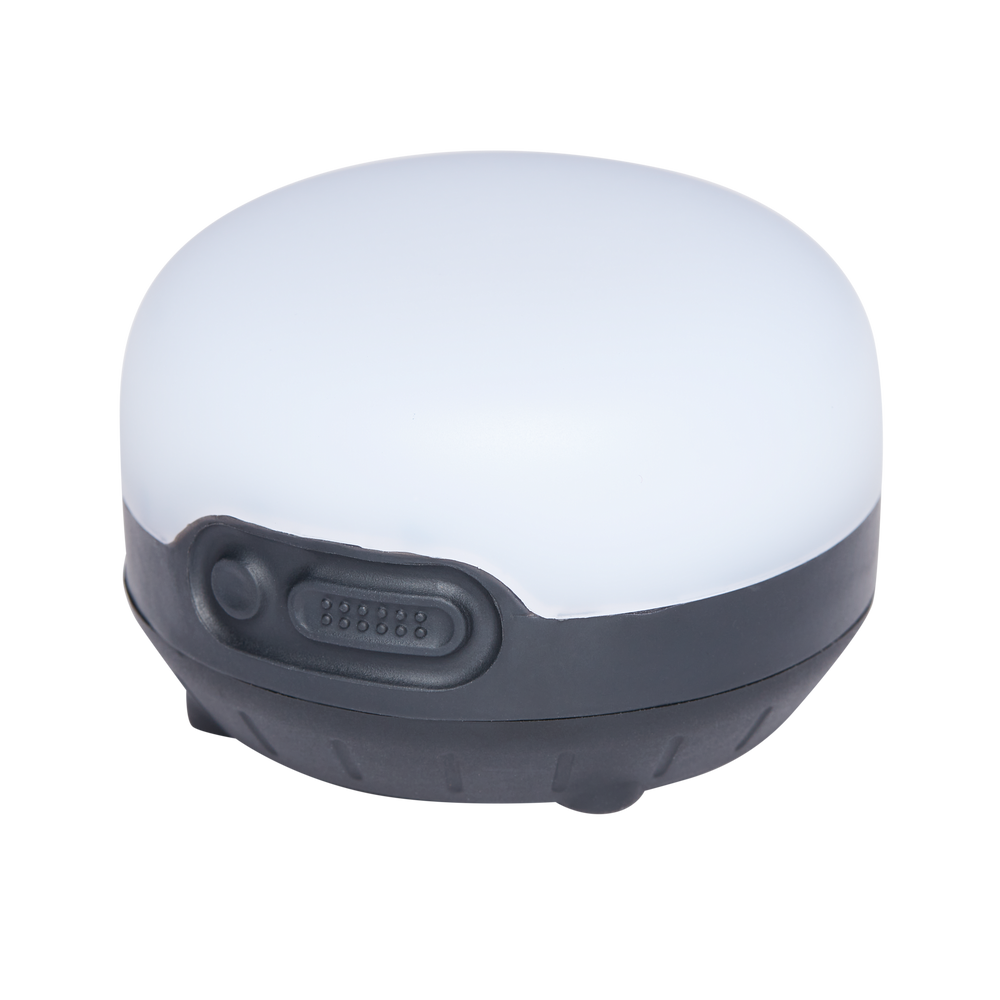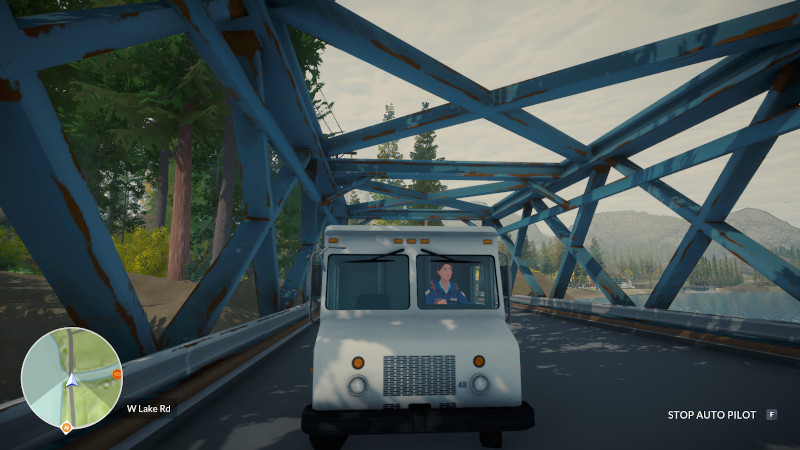Latest reviews
I used to use Twitter but only for reading. I don’t know why but on Mastodon I feel more inclined to actually post statuses.
So this is a city that is supposed to be a fortress for humanity. It is a planned city, for the most part based on an octagonal grid pattern.
Basic structure

Gaps in the octagon are used to house water reservoirs which are interconnected by drainage channels. The city seems to be designed to deal with flooding events. Sounds reasonable considereing that nearby old Tokyo is submerged within the pacific ocean (in this distant future of the year 2015, that is). There also seems to be a reliable alarm system. The whole population fits into onsite emergency shelters. Central city highrise building can be submerged into the ground in case of a catastrophe.
Nature & Environment
The outline of the city blocks vaguely resembles crucifix that is 3.5km on its long axis, which appears tiny to me. But I like the idea of living in a tiny superdense city surrounded by a beautfull green mountain range and a scenic crater lake. Too bad they had to destroy part of a natural reserve (and a golf course) to build it.
Transportation
The city seems to have a reliable monorail system but also a dense grid of six lane roads which seems incredibly car oriented for my taste. Who needs that many lanes? Well maybe if the city is designed to be navigated by giant robots to destroy titanic (alien?) monsters that regularly venture to the city center for no reason.
Pupulation
The city is largly populated by officers of the semi military force NERV with cool uniforms and a weired cult like slogan on their logo. In the later parts of the show, the city appears strangly empty and melancholic. I like the vibe of it but I wouldn’t wanna live there.
The first few chapters are a great journey. The last few chapters feel somewhat convoluted…
This is a small camping lantern for lighting your tent (or whatever really). It’s small in size and the light is bright enough for most uses, while also being dimmable. Positioning is really easy, as it has hooks and magnets in the bottom. It’s also water resistant.
There are also other versions than this R+ but I wouldn’t recommend them, as they can’t be charged with a USB. Speaking of which, it’s a bit embarrassing that the USB in use is of the outdated micro variety and not USB-C.
You can set the lantern to any color, which in my opinion is just spurious. Unnecessary complexity that’s introduced just as a marketing “advantage”. Because of this it’s also a bit overpriced.

The big button controls brightness while the small one operates color. (Credit: Black Diamond. Fair use.)
Wrap up
This is a good lantern which has pretty much all the features you’d want, and some useless extra too. It’s not perfect but I would still recommend this product. It’s also widely available around the globe.
The protagonist holds a stressful job in the big city. Circumstances lead them to an extended stay in their old hometown. They rekindle old relationships, form new ones, and ultimately have to make a big decision.
It’s a trope all too familiar from film and television, but less common in video games. Lake, released by Dutch indie studio Gamious in 2021, embraces the premise wholeheartedly.
Holiday job
The year is 1986. You play as Meredith, a 44-year-old programmer who spends her holiday in her old hometown of Providence Oaks, Oregon. It’s not much of a vacation, though! For two weeks, you fill in for your dad at the local post office, delivering letters and packages to members of the small lakeside community. Meanwhile, your parents are on an actual vacation in Florida.
The core mechanic of the game is to drive the Post Office truck, put letters in mailboxes, and deliver packages to homes and businesses. Occasionally, this offers opportunities for interaction with the town’s residents. These interactions are used to advance a slice-of-life narrative.
There’s no larger plot to uncover here, but you can get involved in small town drama. A lumberjack is protesting plans for real estate development; a young couple is on the run from the law; a small video rental store is fighting for its survival. Many of the characters are one-note stereotypes, but it’s still fun to talk to them.
Trucking along
These interaction opportunities are only delivered in small morsels. You spend a lot of your time just driving around and delivering mail without talking to anyone. (Occasionally, Meredith will issue a bit of monologue when putting a letter into a mailbox, like “Here’s your mail”.)
The local radio station helps break the monotony, until you notice that the same handful of songs keep repeating, at which point you’ll want to turn the radio off to keep your sanity.

Meredith is driving her truck around the lake. Get used to the view, because you’ll be seeing it a lot. (Credit: Gamious. Fair use.)
When outside the truck, Meredith can walk slowly or … walk slowly. In theory, you can accelerate her walking speed, but the increase is almost imperceptible.
Lake, then, is a game best played when you want to let your mind wander. The town is pretty to look at, and there are some nice details, like a fox or a deer crossing the road, or changes in the weather.
Uncanny hometown
Overall, however, the game’s reach exceeds its grasp. There’s a reason most “walking simulators” stick to just that: walking. The driving mechanic is awkward and immersion-breaking—you can drive your truck into anything or anyone without as much as a honk or a frown.
On my system, which plays far more demanding games without issues, the game’s frame rate dropped from time to time, and the audio sometimes fell out of sync. There were also occasional visual glitches: cars floating in the air, people disappearing, lights flashing or flickering. Close-ups on characters are straight from the uncanny valley, with dead stares and robotic lip movement.
The game has three different endings; to its credit, you can pursue a male or female love interest. It doesn’t really broach the issue of small town homophobia in a meaningful way, and I was disappointed in the limited choices it ultimately offered for Meredith’s future.
The Verdict
All in all, I cannot recommend Lake: the mail delivery mechanic is too tedious, the technical problems are too numerous, and the story is too underdeveloped. Indie games like Firewatch and have demonstrated that it’s possible to deliver technically excellent narrative experiences with a small team—Lake never reaches that high bar. That said, many folks have found enjoyment in the game, and if you’re really looking for that small town vibe, you may want to check it out.
Philip Ball is a veteran science writer whose books have shed light on a wide range of subjects, including molecular physics, pattern formation, music psychology, and quantum physics. In The Book of Minds, Ball attempts to penetrate the mystery of “mindedness”.
How would it feel to experience the world like a bat or a bee? Can we create artificial minds? And if alien life forms are out there, how would their minds relate to ours?
Imagination and its limits
Ball introduces the idea of a “space of possible minds” in which to situate any being. Using dimensions such as consciousness, agency, intelligence, and experience, it becomes possible to at least speculate systematically about how an animal mind might differ from our own.
Ball then surveys the forms of thinking, sensing and reacting that can be found in living things. He provides a brief introduction to newer theories of consciousness like Integrated Information Theory, and summarizes the state of artificial intelligence around the time the book was written.
The author frequently reminds us that, while we can speculate about dimensions of “mindspace”, we cannot transcend the limitations of our own minds when imagining the experience of other beings.
That doesn’t stop him from speculating about the possible minds of extraterrestrials. Ball notes that much of our science fiction merely extends human qualities and motivations into “alien” minds—the war-like species, the scientific species, etc. He reaches the obvious conclusion that we can say very little about what alien minds would actually be like.
Why agency matters
In the penultimate chapter, Ball engages in an impassioned defense of the concept of “free will”. While acknowledging that the term is problematic due to metaphysical connotations and lack of clear definition, he argues that the concept of agency as realized through minds is crucial to make sense of the world.
Ball dismisses questions of determinism as irrelevant. Of course, he says, everything happens because it could not be otherwise—that’s a banal, even tautological observation. But the causes of events don’t become more intelligible by reducing a person’s decisions to the interaction between molecules in their brains.
Minds produce decisions—that’s what they evolved to do—and thereby they cause things to happen. That distinguishes minds from other objects in the universe. We therefore need to approach agency as a subject of study: Why and how do minds decide certain things? It’s an implicit defense of fields like psychology for comprehending a universe that has minds in it.
While the chapter is essentially a long philosophical argument, I found it to be the most interesting one in the book. As for the remainder of The Book of Minds, regular readers of science writing are unlikely to encounter a lot of ideas they’ve never heard of before.
The Verdict
Ultimately, Ball’s core subject is riddled with so much uncertainty that it does not really warrant a 500-page book. Readers have to work through a lot of variations of “we don’t know” or “we can’t know” to get to the ideas Ball wants to bring across. That’s a shame, because those ideas are interesting—they’re just buried in prose.
The museum is free and houses quite some nice, informative, sometimes beautiful, sometimes disturbing exhibits illustrating the history of the city and its surroundings since Stone Age. Unfortunately, object labels and other descriptive texts are in German only.
I’ve taken a ride on the Cologne to Hamburg line. In comparison to Deutsche Bahn the ticket was pretty cheap. The service is a bit inferior though I feel. I couldn’t succeed to connect to the wifi apart from a short period of less than a minute though trying on three different devices and two different operating systems.
Unfortunately the schedule on the ticket doesn’t give information on the platform. I could find a bitly short URL redirecting to a Deutsche Bahn page with incomplete platform information. That’s complicated and bad for data privacy.
Public loudspeaker announcements in the train very pretty frequent and partly completely irrelevant admonishing behavior of some individual passengers publicly.
Considering the comparatively affordable price anyway a good option.
A very friendly great place to get good vegan Levantine cuisine in Ehrenfeld. Unfortunately, takeaway packaging isn’t very sustainable, comes with quite some aluminum.
Nos concepteurs navigateurs ont conçu ce ciré femme long afin de vous protéger des embruns et d’une pluie modérée lors de vos navigations. Ce ciré femme long, imperméable et respirant vous préservera durablement dans une pluie modérée et lors de navigations en croisière. (Décathlon)
Les Plus
En taille S, le ciré me va parfaitement dans le sens où il ne tire ou ne me fait des bourrelets nulle part, je me suis cependant reporté sur la taille M qui descend quelques centimètres plus bas au niveau de l’entrejambe, plus large sur les épaules, et qui descend jusqu’aux métacarpes plutôt que le pli du poignet.
Les trois coloris disponibles – jaune, lin et bleu marine – sont en nombre limité mais suffisant, le design est sobre loin des doudounes avec des accents colorés un peu partout.
L’imperméabilité est donnée à 15000 mm Schmerber – ou 60.L.m⁻².h⁻¹. Une rapide recherche sur l’ordre de grandeur donne le GoreTex à 30000 mm. De façon anecdotique, je n’ai que des souvenirs peu agréables du peu de fois où la pluie était supérieure à 2 mm.h⁻¹ sur des trajets d’une heure environ.
Côté poids, rien de spécial. Mesuré, la balance indique un poid de 690 g (environ 20 g de plus que pour la taille S).
À priori, ce ciré léger et respirant s’accorde parfaitement dans une optique d’habillement en couches. La résistance évaporative thermique théorique indiquée est inférieure à 9, soit un peu plus haut que le Gore-tex qui est autour de 5 tandis que les coupe-vents usuels sont peu adaptés à l’activité avec un RET proche de 10. La couche textile intérieur en filet joue probablement un rôle important.
On trouve un total de 5 poches, dont une à l’intérieur. Autrement dit, deux poches à mains, une à portble – pratique pour un ciré qui couvre les poches du pantalon – et deux poches pour glisser des trucs et bricoles.
Surprise inattendue, la fermeture offre deux curseurs pour permettre une meilleure amplitude des jambes. J’ai une vague idée de l’utilité sur un bateau, mais pas besoin de me faire un dessin pour me dire que ça me sera très pratique à vélo !
Dernier détail qui peut et devrait avoir son importance, l’empreinte carbone du produit est annoncée à 29,94 kg CO₂e dont 12 % de gagnés via des méthodes d’écodesign. Je n’ai pas beaucoup de références pour comparaisons, seulement qu’un des objectifs serait de 2 t par an et par personne – personnellement je suis déjà en dessous et plus de la moitié ne résulte pas de choix directs.
Les Moins
Quelques détails m’empêchent d’être totalement ravi par cet achat, mineurs puisque n’handicapant pas la fonctionnalité mais présents.
La couleur « Lin » est légèrement trop jaune à mon goût et j’espérais une couleur plus froide, moins flashy sous la pluie. À l’inverse, quelques bandes réfléchissantes auraient été appréciables.
La coupe est, je suppose, volontairement large pour permettre d’enfiler plusieurs couches. Pour ma part je ne compte pas l’enfiler avec des couches épaisses et ai choisi une taille plutôt moulante, ce qui en parallèle rend les manches un peu courtes – aux plis des poignets au repos. Heurseusement, les « manchons » (sic) extensibles sont relativement discrets et seront un atout une fois sur le vélo. Je n’aurai pas à enfiler de manchon de cyclisme. Un col légèrement plus haut aurait été agréable contre les brises dans le cou.
Les textiles utilisés sont particulièrement rigides, contrairement à des tissus souples le moindre mouvement est particulièrement bruyant, mais en environnement extérieur cela ne se remarque pas tellement. Tout comme les multiples plissures que je ne m’explique pas. Au repos la couche externe montre des plissures à de nombreux endroits, sans qu’il n’y ait de tension particulière appliquée.
Toujours dans le détail, la fermeture est protégée par un rabat et il a été jugé pertinent de lui ajouter des boutons pressions. Je trouve ceux-ci un peu grossiers sur un habit autrement très sobre, mais je comprends que ça puisse être une demande au cahier des charges.
Ce qui n’est pas forcément le cas des poches. Bien que présentes, elles n’offrent qu’un volume relativement faible alors que je n’ai pas des pattounes d’ours. Idem, mon portable est relativement ancien et de petites dimensions mais pas sur que des récents y entrent.
Les Inconnues
Le prix est de 65 €. Tout comme l’empreinte carbone je n’ai que peu de références pour comparer, mais ça me paraît plus que raisonnable et raccord avec l’enseigne Décathlon. De plus, je pense que c’est un investissement sur le long terme – ma croissance étant à priori terminée –, pour lequel j’aurais attendu plus de 3 ans avant de me décider et qui, je l’espère, m’accompagnera de longues années durant – dans le cas contraire la garantie est de 2 ans et je peux demander un remboursement pendant 1 an.
